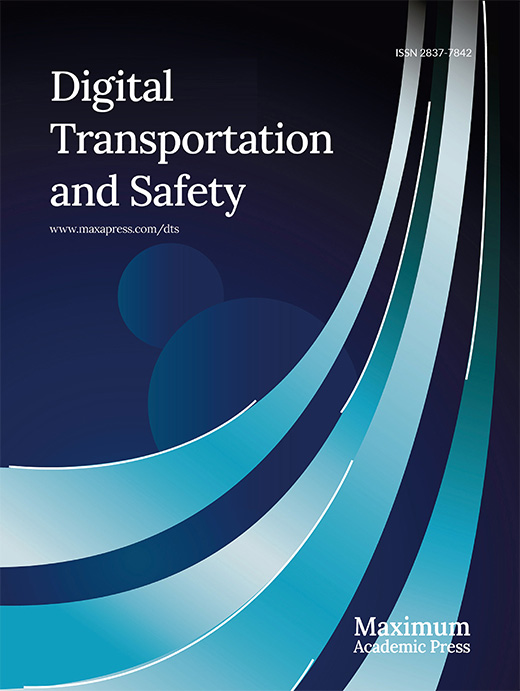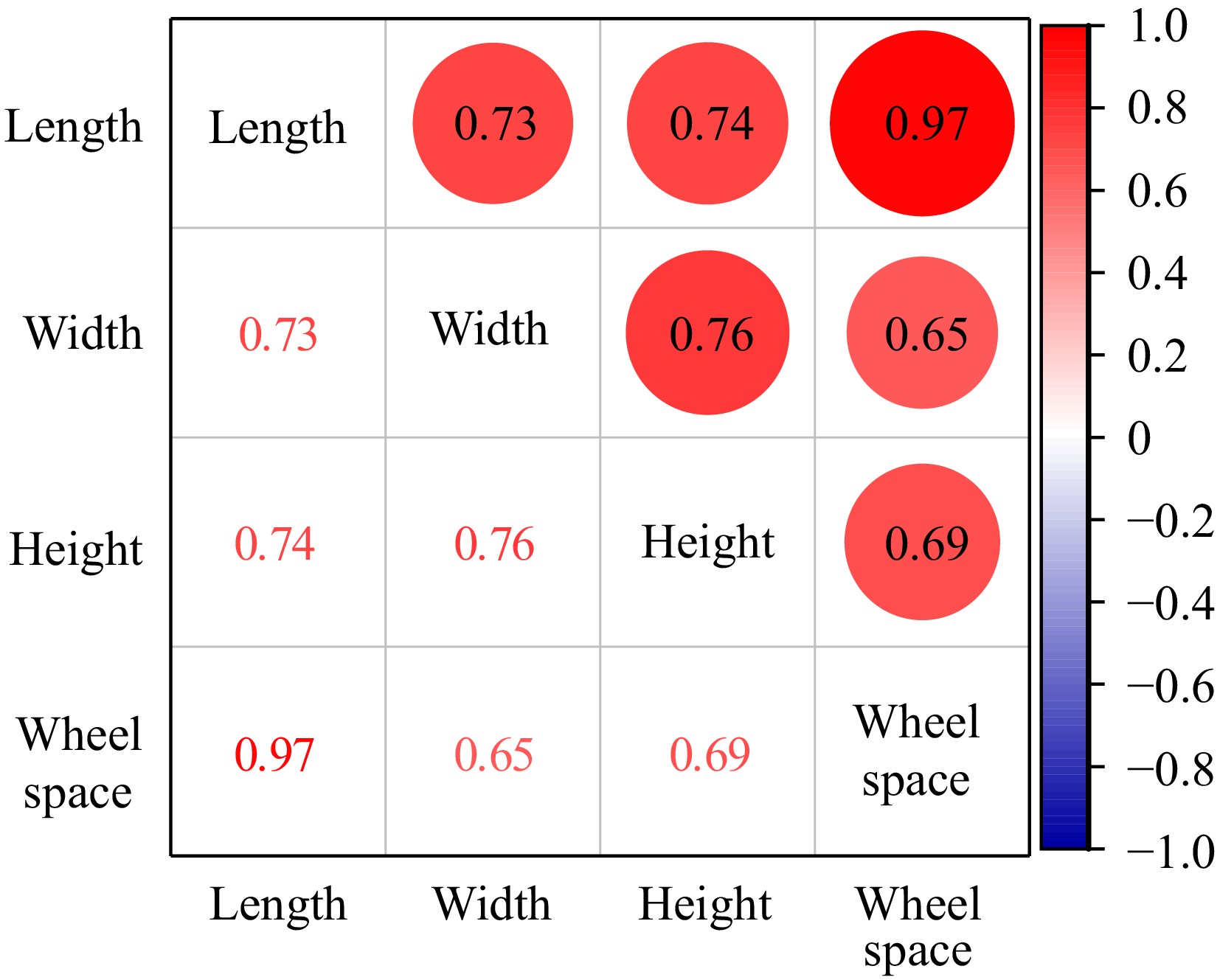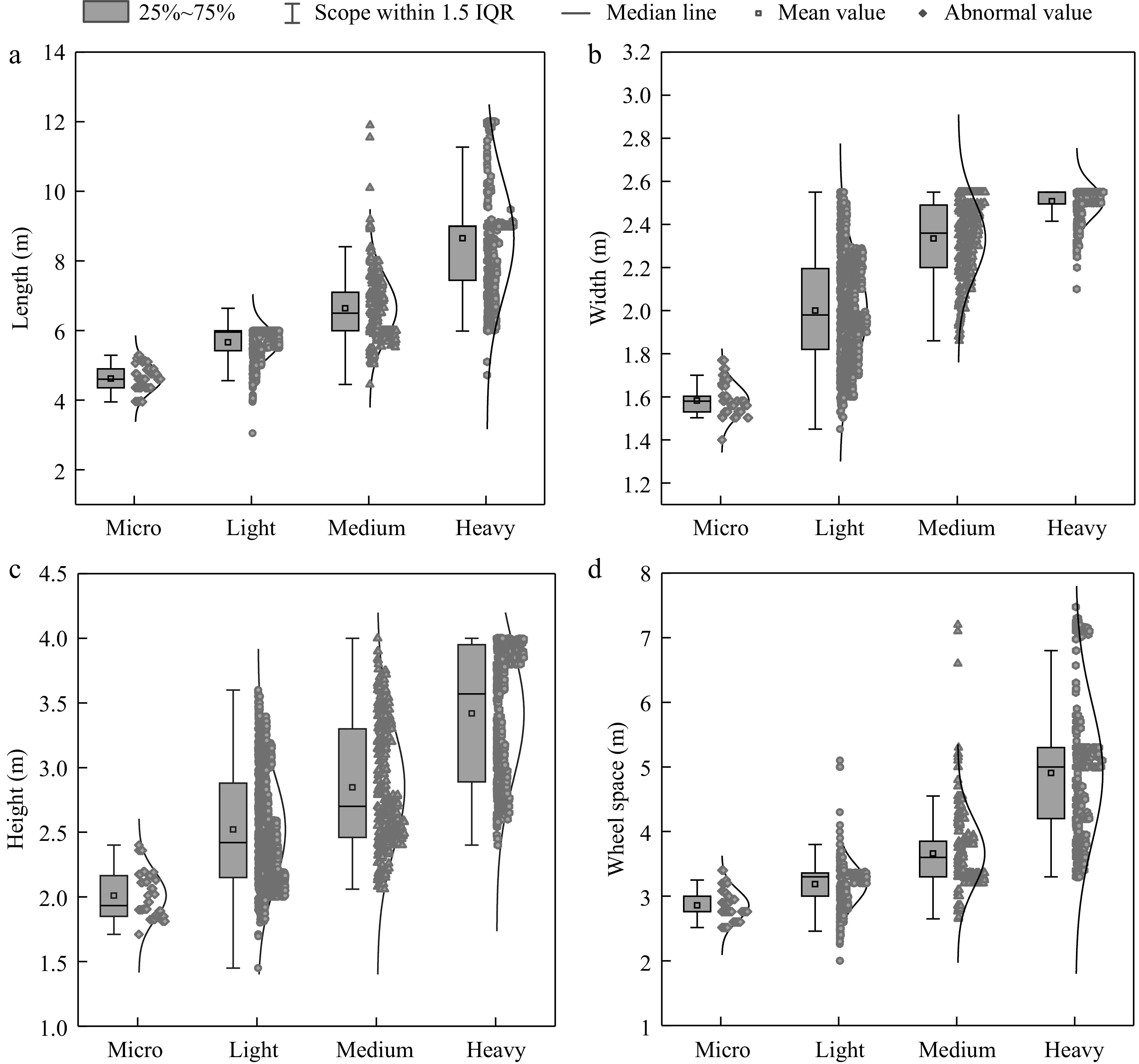-
With the continuous improvement of residents' living standards, people's desire for consumption has gradually increased, leading to a corresponding increase in material needs. Consequently, the demand for goods transportation has also been continuously increasing, as evidenced by the annual growth in the number of freight vehicles. According to data published by the National Bureau of Statistics, from 2016 to 2021, road transport accounted for over 70% of all freight transportation, making it the main mode of freight transportation in China. Furthermore, with the national focus on addressing the 'parking difficulties' faced by trucks and the issuance of the 'Notice on Further Strengthening Truck Parking Services in Public Service Areas' by the General Office of the Ministry of Transport of the People's Republic of China, cargo trucks have become the main service targets on highways and other graded roads, as well as parking spaces. As the mainstay of goods transportation, cargo trucks in the Chinese automobile market (excluding trailers) generally consist of 2-axle, 3-axle, and 4-axle trucks. On highways, the proportion of 2-axle trucks is comparable to that of articulated vehicles (mainly 6-axle semi-trailers), with both holding significant shares among trucks[1]. These truck types are quite diverse, and there are notable differences in their external dimensions. Since the JTJ-81 version of the 'Highway Engineering Technical Standards', the outline dimension of the truck has not changed: the length of the truck is 12 m and the width is 2.5 m. However, after more than 40 years of update iterations, the external dimension of trucks may have changed significantly. The 'Limits for the dimensions, axle loads, and mass of automobiles, trailers and automobile trains' (GB 1589-2016) only specify the maximum limits, thus it is necessary to understand the distribution characteristics of the dimensions of 2-axle trucks. The external dimensions of trucks are an important control factor in the geometric design of roads, serving as the basic reference for road width, turning radius, curve widening, and parking space design. An in-depth analysis of the dimensional parameters and distribution characteristics of 2-axle trucks are beneficial for the optimal design of road facilities and spatial resource utilization. This analysis has significant implications for traffic safety, road capacity enhancement, and maximizing spatial utilization.
In recent years, both domestic and international scholars have conducted extensive research on vehicle dimensions. In the field of road design, Igor et al.[2] utilized distribution functions to validate the convergence of evaluation data and modeling results based on vehicle dimension parameters, and developed an algorithm for calculating highway bridge stiffness spans based on statistical analysis. Gao[3], through analysis of service area design cases, performed calculations on widening values for horizontal curve radii based on the external dimensions of extra-long vehicles. Regarding vehicle type classification, Yan[4] proposed a method for classifying passenger and freight vehicles based on body dimensions and determined representative vehicle models and design speeds for truck-exclusive ramps. Ma et al.[5] established an overtaking model for highways based on body dimensions examined the relationship between body dimensions and safe lateral distances, and, from a safety perspective, defined criteria for passenger and cargo vehicle body dimensions under a vehicle segregation system. Naghmeh et al.[6] introduced a new mathematical method utilizing dimension characteristics, employing the Mean Fuzzy Cluster Algorithm (Fuzzy C-means) alongside the non-fuzzy clustering algorithm K-means to classify passenger vehicles by dimensions, with FCM demonstrating superior classification performance by dividing passenger vehicles into six categories. Chen et al.[7] developed a multinomial logit model for vehicle type selection and a spatial autoregressive (SAR) model for vehicle use based on Household Travel Surveys (HTS) to assess the impact of built environments on vehicle types. Wang[8] analyzed actual data to elucidate the relationship between curb weight and gross weight for various axle types of trucks, classifying trucks based on the discrepancy between vehicle axle type and gross weight. Chai et al.[9], leveraging traffic surveys and vehicle data collection established a database of vehicle parameters, statistically analyzed vehicle parameters, conducted cluster analysis for vehicle classification and determined vehicle classification standards based on wheel space. In terms of vehicle external dimension detection, Iqbal et al.[10] used a computer vision system for height determination utilizing the Gaussian Mixture Model (GMM) and spot detection to detect vehicle height and provide warnings for oversized vehicles. Peng et al.[11] proposed an infrared screen-type automatic measurement technology for vehicle external dimensions based on the CAN bus, enabling rapid and accurate automatic measurement of vehicle external dimensions. Li[12] proposed a cargo vehicle external dimension detection method based on unmanned aerial vehicle LiDAR, addressing deficiencies in existing vehicle dimension measurement methods and verifying the accuracy of the measurement system and the stability of the entire algorithm process through experimental results across various vehicle models.
In the context of vehicle exterior dimension detection and its applications in road design and vehicle type classification, research has predominantly focused on passenger cars and freight trucks. However, with the rapid evolution of the truck market and significant growth in the trucking industry, research specifically targeting 2-axle trucks remains relatively scarce. Wang et al.[13] analyzed the factors affecting the accuracy of the centroid position for 2-axle vehicles. Jiang[14] employed a filtering white noise method to generate a time-domain model of road surface roughness and established a vehicle dynamics model. This model was used to analyze the impact of various factors, including different road surface types, vehicle speeds, axle loads, and suspension damping and stiffness, on the dynamic wheel loads and load factors of 2-axle heavy-duty cargo trucks.
In GA802-2019 'Road Traffic Management Motor Vehicle Types', dimensions such as vehicle body length and gross weight are used to classify freight vehicles into categories such as micro, light, medium, and heavy. According to this standard, two-axle trucks can also be classified into these categories. In the ETC toll classification (JTT 489-2019 'Vehicle classification of the toll for highway'), freight trucks are classified into Type I through VI. Type I and Type II trucks have two axles. According to surveys, road traffic involving freight trucks is significant, accounting for approximately 28% of the total. Among these, two-axle trucks (Type I and II) represent about 31% of the total. They are crucial types of freight vehicles and important considerations in road design.
In summary, both domestic and international research on vehicle exterior dimensions has primarily focused on road design, vehicle classification, and dimension measurement, with most studies concentrated on passenger vehicles. There is a noticeable lack of research on freight trucks, particularly those classified by axle number. There has been no analysis specifically addressing the exterior dimension characteristics of two-axle trucks. Analyzing these characteristics is crucial as it can provide a basis for revising dimension parameters for representative models and parking lot design. Two-axle trucks constitute a significant proportion of freight vehicles and have a considerable impact on road and parking lot design. This study collected data on 7831 two-axle trucks of various models in the Chinese truck market and used statistical methods to conduct an in-depth analysis of their body dimension characteristics. The research aimed to clarify the distribution characteristics of two-axle trucks' external dimensions in China and provided valuable reference and data support for highway design and public service area parking space planning.
-
The data for this study is sourced from the Truck Home website, which covers all domestic truck brands and includes parameters such as external dimensions, weight, engine specifications, and fuel consumption. This website is suitable for the present research as it provides the body dimension parameters for currently available truck models. There are 103 vehicle brands involved, such as Dayun Light Trucks, FAW Jiefang, and Dongfeng. A total of 7,831 truck models were collected from the website, including 47 types of micro trucks, 5,507 types of light trucks, 770 types of medium trucks, and 1,507 types of heavy trucks. Figure 1 shows examples of two-axle trucks of the four types. The classification standards and specific parameters for these four types of two-axle trucks are detailed in Table 1, according to the GA802-2019 standard.

Figure 1.
Examples of different types of two-axle trucks. (a) Micro truck. (b) Light truck. (c) Medium truck. (d) Heavy truck.
Table 1. Accuracy verification of random sampling data.
Classification criteria Vehicle type Sample capacity Sampling quantity Data accuracy rate Bodywork length (m) Gross mass (t) − − > 12 Heavy truck 1507 151 100% ≥ 6 Or 4.5~12 Medium truck 770 77 100% 3.5~6 And 1.8~4.5 Light truck 5507 551 100% ≤ 3.5 And ≤ 1.8 Micro truck 47 5 100% Validation of sample data accuracy
-
The accuracy of the dimensions and other parameters provided by Truck Home was verified using a random stratified sampling method with a sampling proportion of 10%. A total of 783 samples were selected. These samples were compared with the parameter information published on the official websites of respective brands, as shown in Table 1. The accuracy rate for the 783 sampled truck parameters was 100%, with all parameters matching the data published on the official websites. Therefore, the parameter data for trucks collected from the Truck Home website is considered accurate.
-
Statistical analysis was conducted on the external dimension parameters (body length, body width, body height, wheel space) of 7,831 two-axle trucks. A frequency distribution histogram and cumulative frequency curve were plotted, as shown in Fig. 2. The overall characteristic values that reflect the dimensions of two-axle trucks are presented in Table 2. From Fig. 2a and Table 2, it can be observed that the body length of two-axle trucks exhibits an unimodal distribution with a broad range. The minimum vehicle length is 3.05 m, and the maximum is 12 m. The mode of body length is 5.995 m, with 74% of sample vehicle body lengths being less than 6 m. Further analysis indicates that, according to the vehicle classification in GA802-2019 Road Traffic Management, a vehicle body length of 6 m serves as a boundary indicator between light and medium vehicle types. Therefore, nearly three-quarters of the sample vehicle body lengths in two-axle trucks are around 5.9 m.
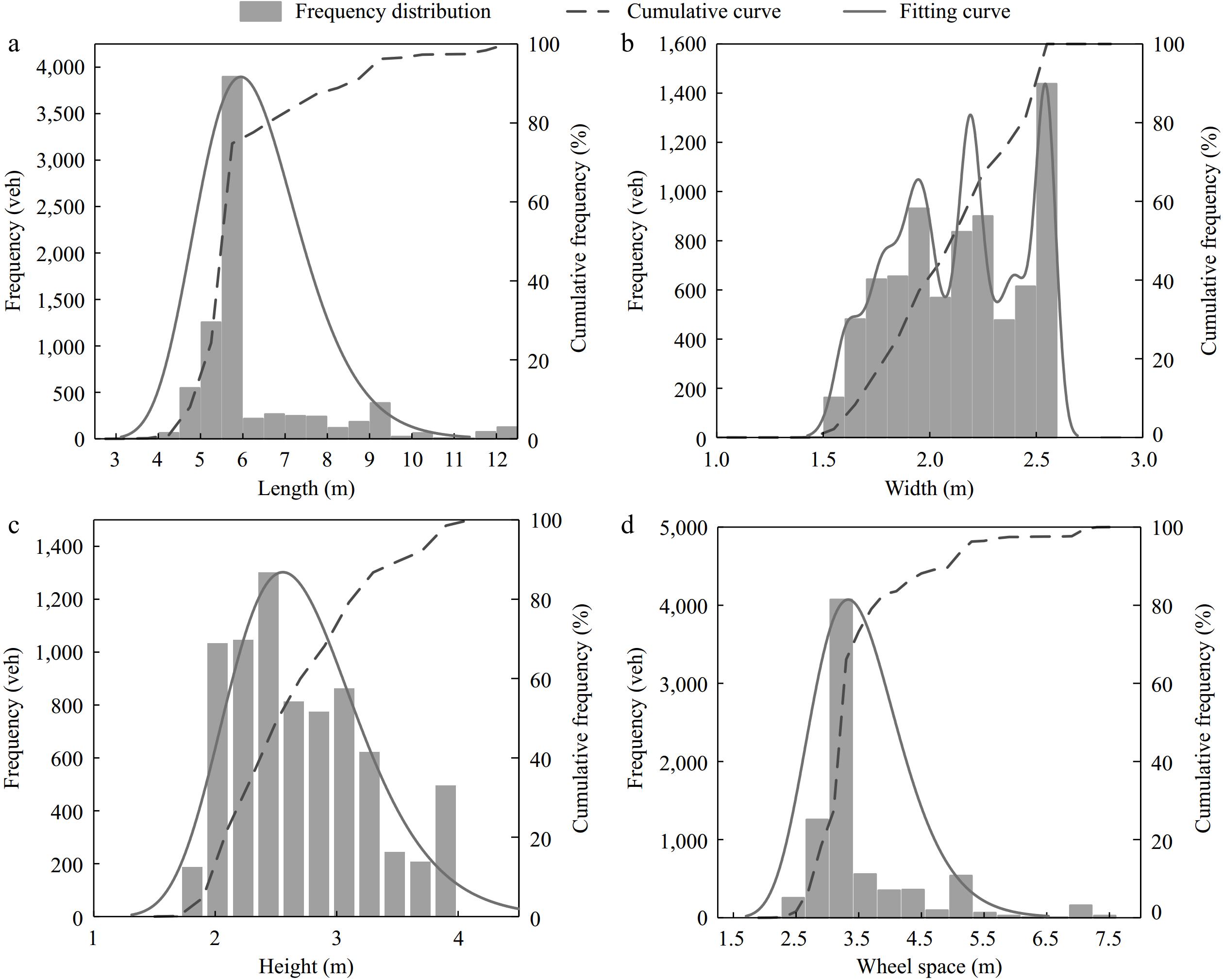
Figure 2.
Overall distribution of outline dimensions. (a) Bodywork length. (b) Vehicle body width. (c) Vehicle body height. (d) Wheel space.
Table 2. Overall eigenvalue of size parameter.
External dimensions 5th 15th 25th 50th 75th 85th 95th Mode Mean value Standard deviation Length (m) 4.873 5.285 5.52 5.995 6.0325 7.6 9 5.995 6.3296 1.4630 Width (m) 1.63 1.78 1.89 2.16 2.4 2.55 2.55 2.55 2.1291 0.2993 Height (m) 2 2.12 2.26 2.6 3.14 3.34 3.95 3.15 2.7242 0.5751 Wheel space (m) 2.7 2.86 3.12 3.36 3.6 4.2 5.3 3.36 3.5605 0.8702 Figure 2b, in conjunction with Table 2, shows that body width exhibits three peaks, with peak values around 1.9, 2.2, and 2.5 m. Approximately 62% of the sample body widths fall within the range of 1.9 to 2.55 m, with all body widths being less than 2.55 m. The presence of multiple peaks in body width can be attributed to variations among different vehicle models. According to the vehicle classification in GA802-2019 Road Traffic Management, the sample vehicles are categorized into four types: micro, light, medium, and heavy. Micro trucks are typically narrower than others, while light trucks exhibit a wide range of widths. Micro and medium trucks overlap more with light trucks, with most distributed between 1.6 and 2.2 m, whereas heavy trucks are predominantly concentrated around 2.5 m.
From Fig. 2c, it can be observed that there is a peak in body height around 2.4 m, with approximately 85% of the body heights in the sample distributed between 2 and 3.5 m. The minimum body height is 1.45 m, the maximum height is 4 m, and the mode is 3.15 m. Figure 2d illustrates that the vehicle wheel space follows a single-peak distribution, with the mode around 3.3 m. The wheel space is primarily distributed between 2.5 and 4.5 m, comprising about 87% of the sample. The distribution characteristics of the wheel space are similar to those of the body length, both exhibiting single-peak distributions.
Based on the overall characteristic value distribution data for two-axle lorries presented in Table 2, it is evident that 85% of vehicles have body lengths of less than 7.6 m, widths of less than 2.55 m, heights of less than 3.34 m, and wheel spaces of less than 4.2 m. These measurements represent the body dimensions of the majority of two-axle lorries in China.
Correlation analysis of external dimension parameters
-
To clarify the correlations among body length, width, height, and wheel space, Pearson correlation analysis was conducted on the size parameters of two-axle trucks using Origin software. The results, shown in Fig. 3, use red to represent positive correlations and blue to represent negative correlations. According to the Pearson correlation coefficients presented in Table 3, the correlation coefficient between wheel space and body length is 0.97, indicating a very strong positive correlation. The correlations between body length and width, body length and height, and body width and height are also strong, with coefficients of 0.73, 0.74, and 0.76, respectively. On the other hand, the correlation coefficients between wheel space and body width, and between wheel space and body height, are relatively weaker, at 0.65 and 0.69, respectively, indicating moderate positive correlations. Overall, there is a positive correlation among all four body dimension parameters.
Table 3. Correlation degree and direction of Pearson coefficient.
Correlation
coefficient rangeCorrelation degree Correlation direction 0.8 < r < 1 Extremely strong Positive 0.6 < r < 0.8 Strong Positive 0.4 < r < 0.6 Moderate Positive 0.2 < r < 0.4 Weak Positive 0 < r < 0.2 Extremely weak or irrelevant Positive 0 Irrelevant None −0.2 < r < 0 Extremely weak or irrelevant Negative −0.4 < r < −0.2 Weak Negative −0.6 < r < −0.4 Moderate Negative −0.8 < r < −0.6 Strong Negative −1.0 < r < −0.8 Extremely strong Negative Linear regression analysis of dimension parameters
-
Based on the correlation matrix of dimensional parameters, linear regression analysis was performed on each pair of dimension parameters to identify the relationships among the primary dimensions. As shown in Fig. 4, abrupt cutoff points in the data are observed at a length of 12 m, a width of 2.55 m, and a height of 4 m. These discontinuities are attributable to the dimensional constraints specified in GB1589-2016, which governs the external dimensions, axle loads, and mass limits of trucks. According to these regulations, the maximum width for various types of trucks is 2.55 m, the maximum height is 4 m, and the maximum length (excluding trains) is 12 m.
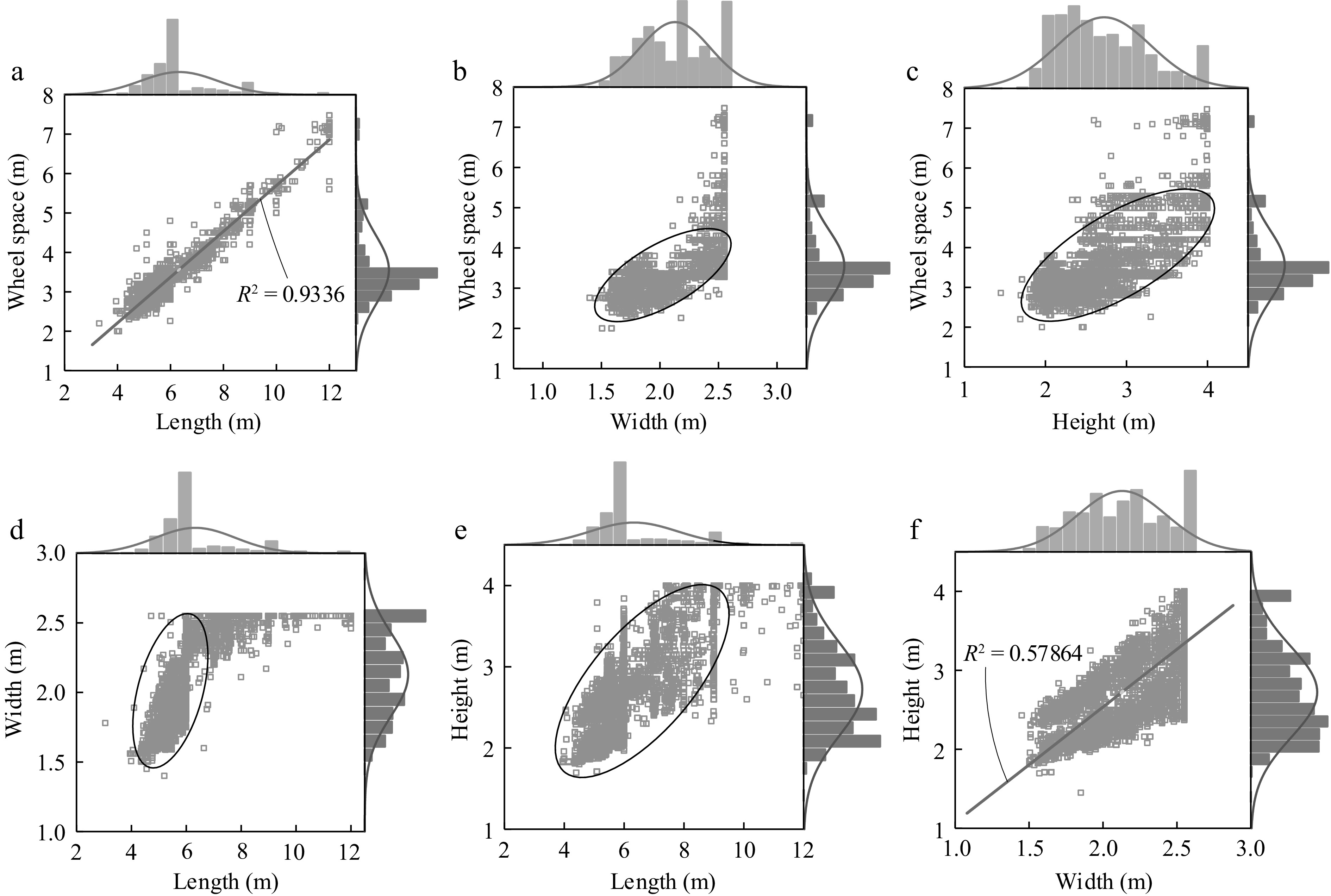
Figure 4.
Regression relationships between pairs of dimensional parameters. (a) Length—wheel space. (b) Width—wheel space. (c) Height—wheel space. (d) Length—width. (e) Length—height. (f) Width—height.
In Fig. 4a, the samples of vehicle length and wheel space are evenly distributed around the regression curve, indicating a nearly proportional relationship between these two variables. Figures 4b and c show that both vehicle height and width increase proportionally with wheel space until reaching their respective maximum limits. Beyond these limits, only the wheel space continues to vary. Compared to the distribution of width and wheel space, the relationship between height and wheel space is more dispersed. Figure 4d illustrates a linear relationship between length and width up to 6 m, after which the vehicle width reaches its maximum limit of 2.55 m, while length continues to increase. In Fig. 4e, the linear trend between length and height ceases once the height reaches the 4 m limit. Figure 4f shows that the linear relationship between width and height persists until the width reaches 2.55 m, after which the relationship sharply diminishes. There is a strong correlation between vehicle length and width (Fig. 4d), vehicle length and height (Fig. 4e), and vehicle width and height (Fig. 4f).
Due to these inter-variable correlations, the linear relationship between wheel space and length results in similar distribution patterns between wheel space and width/height. These interrelationships indicate a close connection between different aspects of vehicle dimensions, underscoring the importance of considering these factors comprehensively in vehicle and road design.
Detailed external dimension characteristics of subdivided vehicle types
-
In the specifications and requirements for motor vehicles section of GA802-2019 'Road Traffic Management - Types of Motor Vehicles', the classification descriptions for freight vehicles are detailed. Vehicle body length is one of the key distinguishing criteria for micro, light, medium, and heavy freight vehicles. Therefore, it is necessary to conduct a classification analysis of the dimension parameters of different vehicle types. This analysis can provide a basis for determining the design of vehicles for road infrastructure.
Distribution characteristics of vehicle body length
-
The frequency distribution and cumulative frequency of the body length for four categories of two-axle trucks (micro, light, medium, and heavy) are depicted in Fig. 5. The body length distribution for micro two-axle trucks ranges from 3.9 to 5.3 m, with a mode value of around 4.39 m. For light two-axle trucks, the length distribution ranges from 3 to 6.6 m, with a mode value around 5.9 m. The length range for medium two-axle trucks overlaps with that of heavy trucks, spanning from 4 to 12 m, with a mode value of around 6 m, similar to that of light trucks. Heavy trucks, characterized by the longest body lengths, are concentrated around 8.9 m.
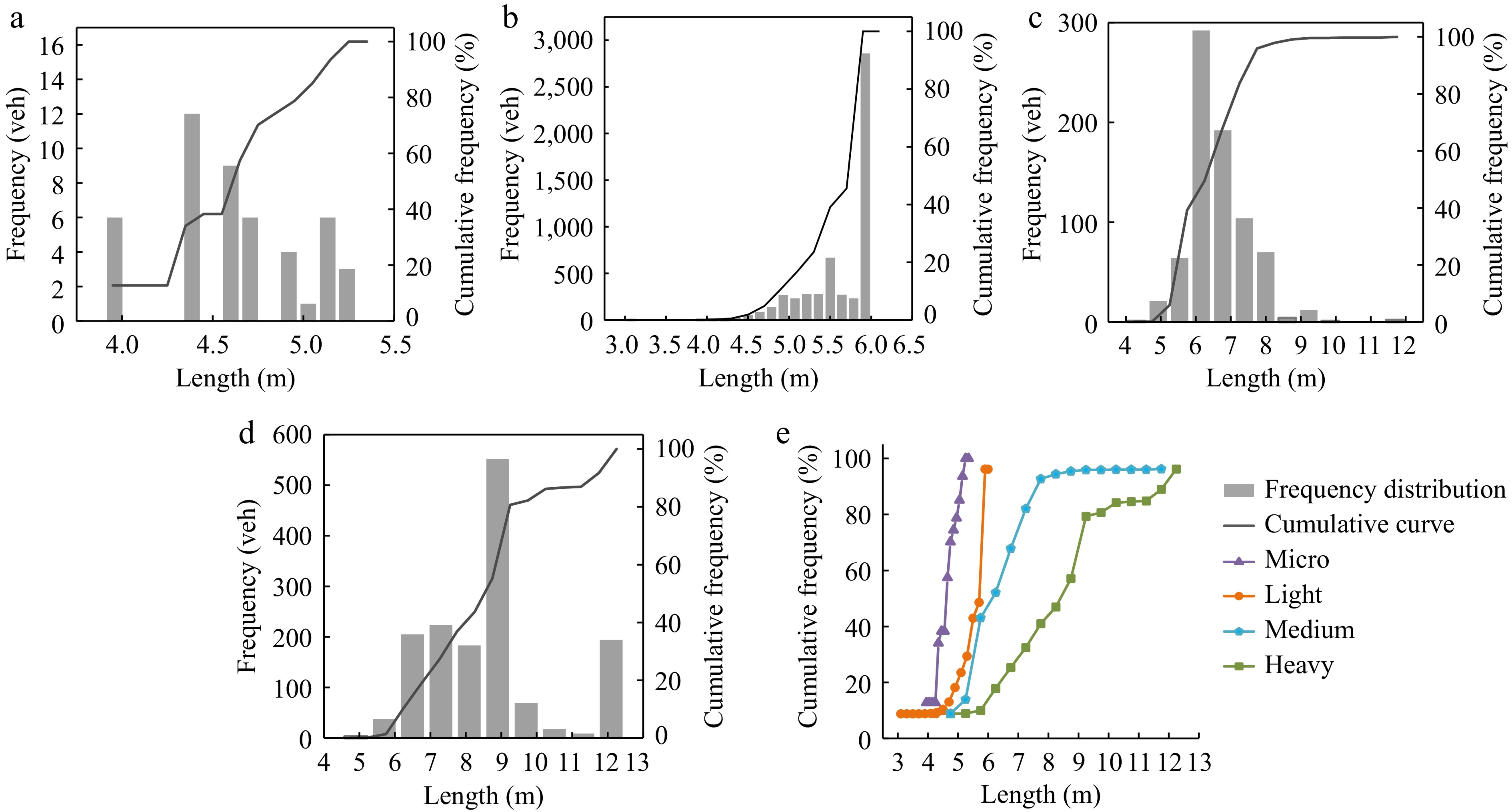
Figure 5.
Body length distribution of different goods vehicles. (a) Micro. (b) Light. (c) Medium. (d) Heavy. (e) Cumulative frequency curve.
In micro and light two-axle trucks, 98% of sample vehicle body lengths are below 6 m. This is because 6 m is a key criterion in China's public safety industry standards for distinguishing between light and medium vehicles. To comply with regulations, vehicle manufacturers ensure that the body length does not exceed 6 m during production. The lengths of two-axle trucks in medium and heavy categories are more varied. Heavy trucks are classified based solely on gross mass, while medium trucks are classified using two criteria: gross mass and vehicle length, with meeting either criterion being sufficient.
Distribution characteristics of vehicle body width
-
Figure 6 illustrates the frequency distribution and cumulative frequency curves of body width for four distinct vehicles types. Observing the graph, it is noted that among two-axle trucks, micro vehicles primarily range in width from 1.4 to 1.8 m, while light and medium trucks share a similar width spectrum of 1.4 to 2.6 m. In contrast, heavy trucks span from 2.1 to 2.9 m in width. The mode width for micro vehicles is 1.58 m, light trucks display dual peaks around 1.9 and 2.2 m, with a mode width of 2.2 m, and heavy trucks mirror medium trucks with a modal width of 2.55 m. Notably, heavy trucks boast the widest body width among the four vehicle types, all exceeding 2 m. Over 50% of light and medium trucks exceed 2 m in width, while all micro trucks remain below this threshold.
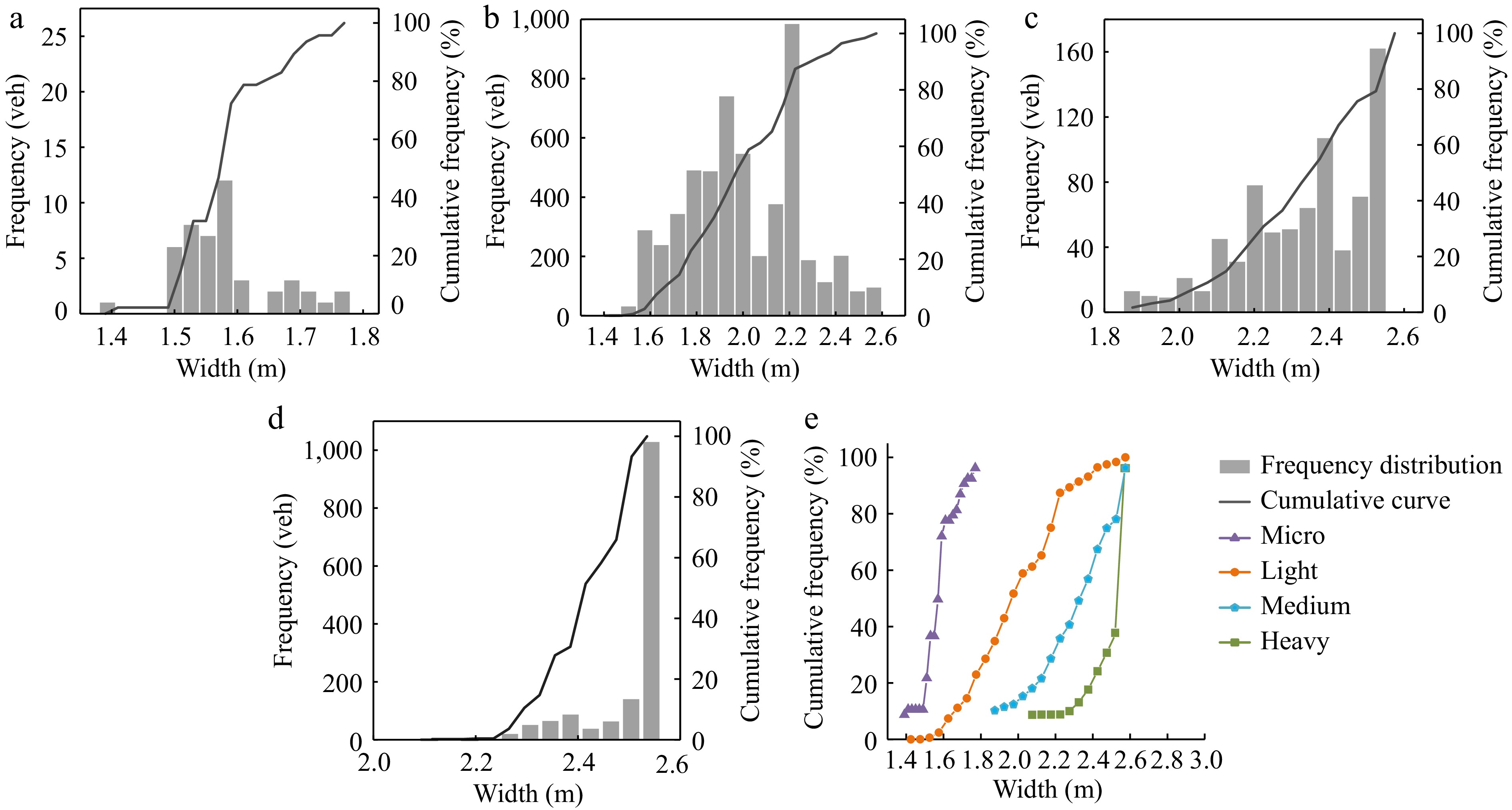
Figure 6.
Body width distribution of different goods vehicles. (a) Micro. (b) Light. (c) Medium. (d) Heavy. (e) Cumulative frequency curve.
For transporting substantial quantities of goods over extended distances, the driver's cabin must offer ample rest space for the driver. Hence, heavy trucks possess a broader body width compared to other vehicle types. According to the 'Technical Standards of Highway Engineering' and the 'Design Specification for Highway Alignment', the prescribed body width for freight vehicles is 2.5 m. From Fig. 6e, it is apparent that excluding micro trucks, light, medium, and heavy trucks frequently exceed this width. In heavy two-axle trucks, more than 60% of samples measure 2.55 m in width, suggesting a need for revision in the designated body width for freight vehicles.
Distribution characteristics of vehicle body height
-
Figure 7 depicts the frequency distribution and cumulative curves of body height for four vehicle types. Micro trucks exhibit a height distribution ranging from 1.7 to 2.4 m, with a mode value of around 1.9 m. Light trucks range in height from 1.4 to 3.6 m, with a mode value of 3.15 m. Medium trucks span from 2 to 4 m in height, with a mode value of 2.6 m. Similarly, heavy trucks have a height distribution ranging from 2.4 to 4 m, with a mode value of 4 m. Generally, heavy two-axle trucks display the tallest heights.
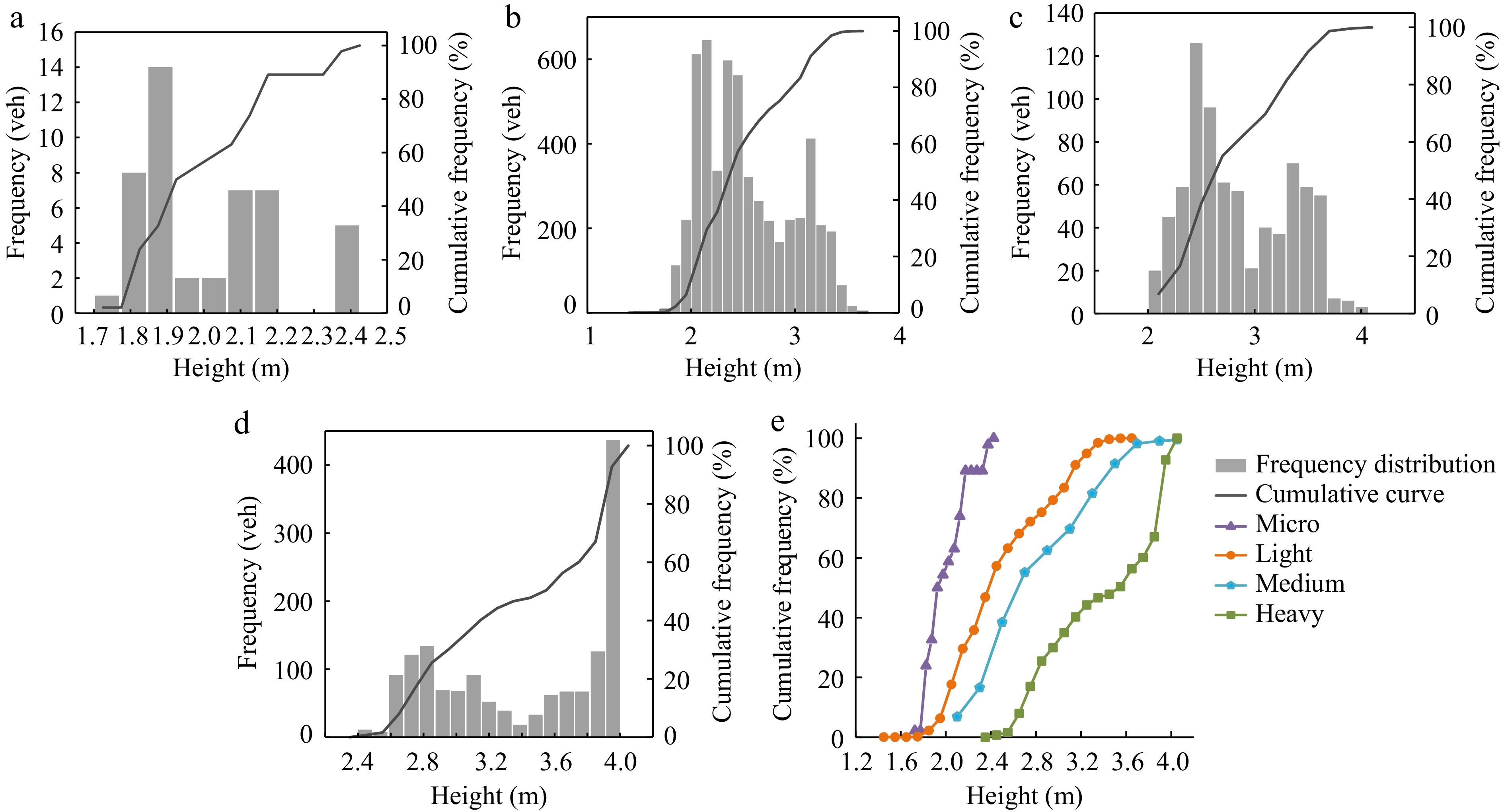
Figure 7.
Height distribution of different goods vehicle bodies. (a) Micro. (b) Light. (c) Medium. (d) Heavy. (e) Cumulative frequency curve.
The increased height of heavy trucks is attributed to their primary role in transporting large volumes of goods. Taller body heights allow for greater cargo capacity. Furthermore, taller chassis can enhance a truck's ability to navigate obstacles and improve its performance across diverse road conditions, essential for transporting goods to various destinations.
Distribution characteristics of vehicle wheel space
-
Figure 8 shows the frequency distribution of wheelbase for the four vehicle types. The graph indicates that the wheelbase of micro trucks ranges from 2.4 to 3.4 m, with a mode value of 2.76 m. Light trucks have a wheelbase ranging from 2 to 5 m, with a mode around 3.3 m. Medium trucks exhibit wheelbases from 2.5 to 7.5 m, with a mode around 3.4 m. Heavy trucks have a wheelbase range of 3 to 7.5 m, with a mode value of around 5 m. Heavy two-axle trucks feature the largest wheelbase, which is crucial for maintaining stability when loaded with goods. A larger wheel space enhances stability and allows for a longer body length, which is necessary for transporting larger quantities of cargo.
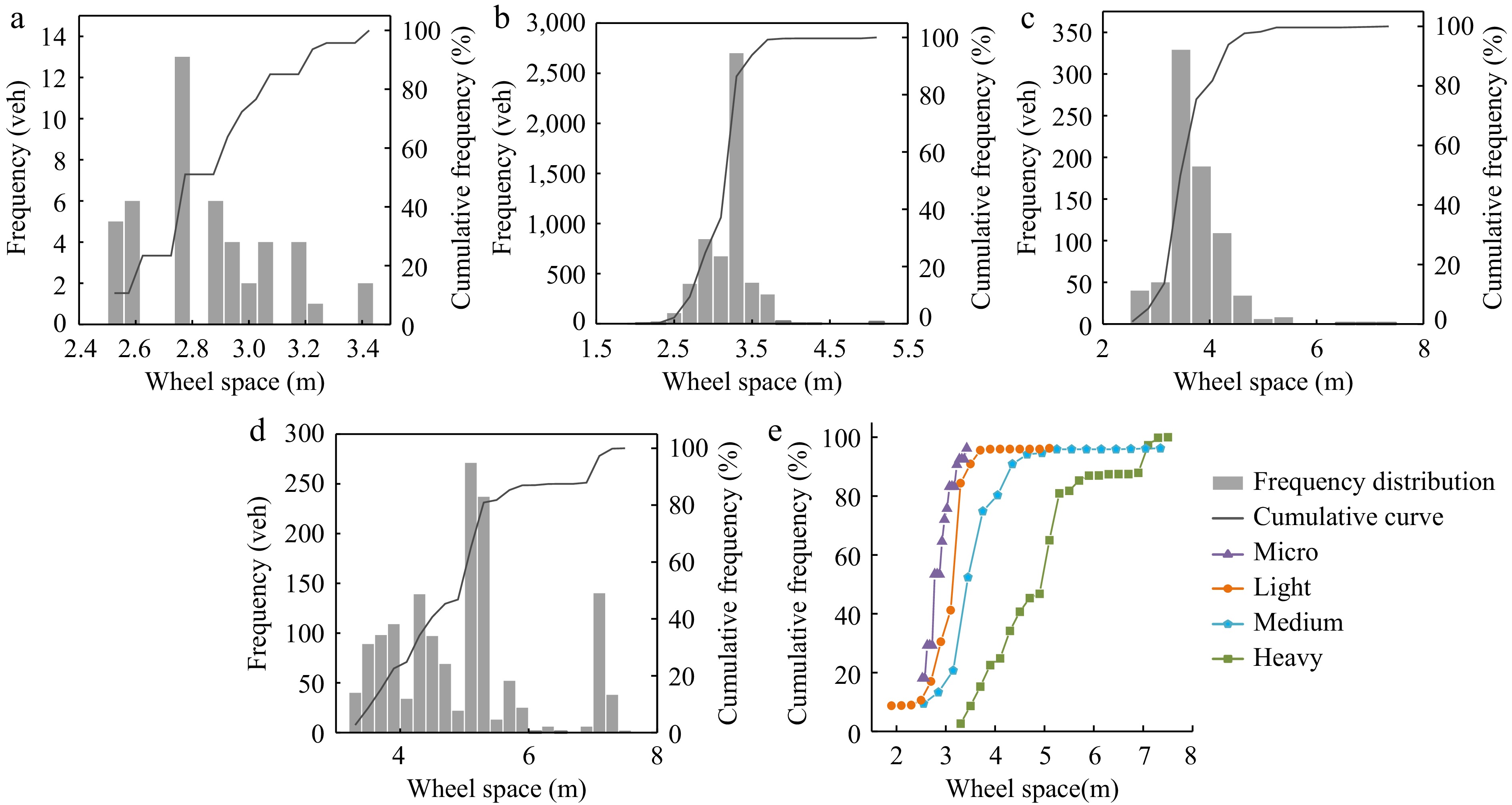
Figure 8.
Wheel space distribution of different vehicle bodies. (a) Micro. (b) Light. (c) Medium. (d) Heavy. (e) Cumulative frequency curve.
Comprehensive analysis of vehicle body dimensions
-
Based on the descriptions provided previously and the statistical data on different types of two-axle trucks shown in Fig. 9, a comparison chart of the main size parameters for these trucks have been plotted. The body length, body width, body height and wheelbase of two-axle trucks exhibit the following trend from largest to smallest: heavy trucks > medium trucks > light trucks > micro trucks. There is a significant difference in the external dimensions among the four vehicle types of two-axle trucks.
-
In mixed traffic flows involving both passenger and freight vehicles, significant interference between buses and trucks often leads to a higher accident rate. The implementation of passenger and cargo separation (where buses and trucks use separate lanes, travel at different times or follow distinct routes within the road transport system) highlights the increasing importance of considering truck external dimensions in the design of segregated highways. According to the JTG B01-2014 'Technical Standards of Highway Engineering'[15] and the JTG D20-2017 'Design Specification for Highway Alignment'[16], cargo vehicles are classified as a distinct category alongside small passenger cars, with a design standard of 12 m × 2.5 m × 4 m. This standard is established to accommodate the exterior dimensions of over 85% of vehicles, serving as the design vehicle standard[17].
With the rapid development of the automotive industry, the proportion of various types of trucks on the roads, particularly two-axle trucks is continuously increasing. Given the wide range of vehicle models and sizes for trucks, the existing single design standard for freight vehicles does not fully meet the requirements of contemporary road designs. Therefore, it is necessary to conduct statistical analysis on the outer dimension characteristic values of two-axle trucks in China, as presented in Table 4.
Table 4. Characteristic values of external dimensions of two-axle freight vehicles of different types.
External dimensions Vehicle types 50th 85th 95th 99th Mode Mean value Standard deviation Max value Length Micro 4.6 5.09 5.2 5.288 4.6 4.620 0.3812 5.288 Light 5.995 5.995 5.995 5.995 5.95 5.659 0.4248 5.999 (6) Medium 6.5 7.55 7.995 8.999 6.5 6.636 0.8734 11.9 Heavy 8.995 10.04 12 12 8.995 8.650 1.6858 12 Width Micro 1.58 1.68 1.73 1.77 1.58 1.583 0.0744 1.77 Light 1.98 2.22 2.4 2.55 1.98 2.000 0.2381 2.55 Medium 2.36 2.55 2.55 2.55 2.36 2.334 0.1783 2.55 Heavy 2.55 2.55 2.55 2.55 2.55 2.508 0.0752 2.55 Height Micro 1.9325 2.195 2.36 2.4 1.9325 2.010 0.1828 2.4 Light 2.42 3.1 3.3 3.4 2.42 2.521 0.4292 3.6 Medium 2.7 3.45 3.65 3.84 2.7 2.847 0.4779 4 Heavy 3.57 3.99 4 4 3.57 3.418 0.5173 4 Wheel space Micro 2.76 3.08 3.25 3.4 2.76 2.859 0.2368 3.4 Light 3.3 3.365 3.6 3.7 3.3 3.187 0.2940 5.1 Medium 3.55 4.2 4.5 5.2 3.55 3.659 0.5188 7.2 Heavy 5 5.7 7.15 7.3 5 4.905 1.0746 7.475 The values in brackets ( ) are recommended values after rounding. In the ETC toll standards for expressways, cargo vehicles are classified into Type I through Type VI trucks[18]. Type I and Type II trucks both have two axles, with the classification boundary defined by body length and gross mass. Type I trucks are those with a body length of less than 6 m and a gross mass of less than 4.5 t. Conversely, Type II trucks are characterized by a body length exceeding 6 m or a gross mass greater than 4.5 t but less than 18 t[19].
Based on the sample distribution, the actual distribution of two-axle trucks on the road, and the classification criteria for toll collection on expressways, two-axle trucks can be divided into two major categories. The first category includes Type I trucks, which consist of micro and light trucks. The second category includes Type II trucks, which encompass medium and heavy trucks. Since light trucks dominate the first category, they are considered representative of Type I trucks. Similarly, heavy trucks dominate the second category, making them representative of Type II trucks. The maximum dimensions of the selected representative vehicles are used as standards. According to the maximum allowable width for two-axle trucks specified in GB1589-2016 'Certification and Accreditation Administration. Limits of dimensions, axle load and masses for motor vehicle, trailers and combination vehicle'[20], which is 2.55 m, the design standard for the representative Type I truck is set at 6 m × 2.55 m × 3.6 m, while the design standard for the representative Type II truck is 12 m × 2.55 m × 4 m. The schematic is illustrated in Fig. 10, and a comparison between the existing design vehicle standards in regulations and the recommended design vehicle standards in this article is shown in Table 5.
Table 5. Comparison table of standard values and recommended values.
Type Name Design standard Original specification value Technical Standards of Highway Engineering 12 m × 2.5 m × 4 m Design Specification for Highway Alignment Recommended values for representative models Type-I 6 m × 2.55 m × 3.6 m Type-II 12 m × 2.55 m × 4 m Design vehicle types for parking spaces
-
According to the current JGJ100-2015 'Code for Design of Parking Garage Building', Table 4 specifies the external dimensions for design vehicles, categorizing trucks into medium and large types only. The design standard for medium trucks is 9.00 m × 2.50 m × 4.00 m, while for large trucks, it is 11.50 m × 2.50 m × 4.00 m. Although design dimensions are provided for micro, small, and light vehicles, there is no specific consideration for micro and light trucks. Given the increasing variety of trucks on the roads and the significant differences in their outline dimensions, particularly between micro and light trucks, it is necessary to revise the design standards for parking spaces in garages. This article addresses the inclusion of a majority of micro and light trucks within the two-axle truck category in the Chinese market. Therefore, revising the designated vehicle types for parking spaces offers significant reference value.
Using the k-means clustering analysis function in Origin to classify the sample parameters of length, width, and height, the clustering results are presented in Table 5. Re-classifying the sample data based on the outline dimensions is advantageous for optimizing space utilization in public parking facilities, such as garages. This is particularly important given the substantial width differences between micro and light trucks within highway ETC toll vehicle types. Consequently, three clustering centers are established: category 1 for micro trucks, category 2 for Type I vehicles, and category 3 for Type II vehicles. Design vehicle types for parking garages must accommodate 95% of the vehicle outline dimension requirements[21]. Therefore, the 95th percentile values of the outline dimensions for each vehicle type, as determined through classification, are statistically analyzed. Safety margins are then applied, and the recommended design values are selected and rounded off, as shown in Table 6.
Table 6. Body dimension clustering results and eigenvalue.
Category Vehicle types Clustering center 95th value Recommended value of design vehicle type Length Width Height Length Width Height Length Width Height 1 Micro 5.375 1.831 2.233 5.995 2.095 2.7 6 2.1 2.7 2 Type-I 6.191 2.253 2.866 7.4 2.55 3.45 7.5 2.55 3.5 3 Type-II 9.425 2.538 3.613 12 2.55 4 12 2.55 4 -
By analyzing the external dimensions data of two-axle trucks in the Chinese automobile market, we have obtained a comprehensive understanding of the overall characteristics of these vehicles and examined the relationships between various dimensions. The dimension distribution characteristics of four types of two-axle trucks — micro, light, medium, and heavy — were identified. Additionally, the design vehicle types for highways and parking garages were determined, and the outline dimensions of the design vehicles were provided. The main research conclusions are as follows:
(1) The dimensions of two-axle trucks in China generally fall within specific ranges: the body length ranges from 4.5 to 6 m, with a mode value of 5.995 m; the body width primarily typically spans from 1.9 to 2.55 m, with a mode value of 2.55 m; the body height is predominantly between 2 and 3.5 m, with a mode value of 3.15 m; and the wheel space ranges from 2.5 and 4.5 m, with a mode value of 3.3 m.
(2) There is a very strong positive correlation between the body length and wheel space of two-axle trucks. The correlation between the wheel space and body width, as well as between the wheel space and body height, is relatively weaker. Additionally, there is a strong correlation between body length, width, and height.
(3) The characteristics of the outline dimensions for four types of two-axle trucks, based on mode values, are as follows: micro trucks have dimensions of 4.6 m × 1.58 m × 1.825 m; light trucks measure 5.995 m × 2.2 m × 3.15 m; medium trucks are 5.995 m × 2.55 m × 2.6 m; and heavy trucks have dimensions of 9 m × 2.55 m × 4 m. There are significant differences in the outline dimensions among the different vehicle types, with the hierarchy being: heavy trucks > medium trucks > light trucks > micro trucks.
(4) Based on sample distribution, actual vehicle types on the roads, and highway toll standards, two representative types of two-axle lorries have been identified. Type I truck is represented by light trucks with dimensions of 6.0 m × 2.55 m × 3.6 m, while Type II truck is represented by heavy trucks with dimensions of 12 m × 2.55 m × 4 m.
(5) Using the k-means algorithm to cluster the outline dimensions of two-axle trucks, three categories were identified: micro truck, Type I truck, and Type II truck. Based on the 95th percentile, the design vehicle dimensions are as follows: 6.0 m × 2.1 m × 2.7 m for micro trucks, 7.5 m × 2.55 m × 3.5 m for Type I trucks, and 12.0 m × 2.55 m × 4.0 m for Type II trucks. These categories provide three options for public parking service areas.
This research was sponsored by the Chongqing Transportation Science and Technology Project, China (Grant No. CQJT-2023CZ32-2).
-
The authors confirm contribution to the paper as follows: study conception and design: Jin X; analysis and interpretation of results: Yang X, Yu Z, Wang C, Zhu X, Yi G; draft manuscript preparation: Yang X, Yu Z, Wang C, Zhu X, Yi G. All authors reviewed the results and approved the final version of the manuscript.
-
Data sharing is not applicable (no new data was generated).
-
The authors declare that they have no conflict of interest.
- Copyright: © 2024 by the author(s). Published by Maximum Academic Press, Fayetteville, GA. This article is an open access article distributed under Creative Commons Attribution License (CC BY 4.0), visit https://creativecommons.org/licenses/by/4.0/.
-
About this article
Cite this article
Yang X, Yu Z, Wang C, Zhu X, Yi G, et al. 2024. Characteristics of the overall dimensions of two-axle trucks in China and the determination of representative vehicle parameters. Digital Transportation and Safety 3(4): 199−209 doi: 10.48130/dts-0024-0018
Characteristics of the overall dimensions of two-axle trucks in China and the determination of representative vehicle parameters
- Received: 27 June 2024
- Revised: 01 August 2024
- Accepted: 20 August 2024
- Published online: 27 December 2024
Abstract: To clarify the distribution characteristics of the external dimensions of two-axle trucks in the current market in China, and to provide a basis for revising relevant design standards and specifications for cargo vehicle parameters, statistical methods were used to analyze the correlation and distribution characteristics of the external dimension parameters of two-axle trucks. Based on the analysis results, combined with the types of vehicles used for highway tolls, representative models for two-axle trucks and parking garage design models were determined. The study results showed that there is a strong positive correlation between the length and wheel space of two-axle trucks, whereas the correlation between wheel space and body width or height is relatively weak. The external dimensions are ranked as follows: heavy trucks > medium trucks > light trucks > micro trucks, with micro trucks having a significant difference in body width compared to other types of goods vehicles. Based on the data, it is suggested that the representative model for Type I trucks be determined as a light truck with external dimensions of 6.0 m × 2.55 m × 3.6 m, and the representative model for Type II trucks is a two-axle heavy truck with external dimensions of 12 m × 2.55 m × 4 m. The representative vehicle types and their external dimensions for truck parking garage design are as follows: micro trucks − 6 m × 2.1 m × 2.7 m, Type I trucks − 7.5 m × 2.55 m × 3.5 m, Type II trucks − 12 m × 2.55 m × 4 m.
-
Key words:
- Traffic engineering /
- Two-axle truck /
- External dimensions /
- Design vehicle /
- Parking space


